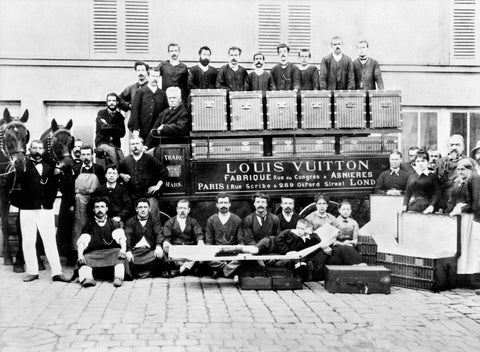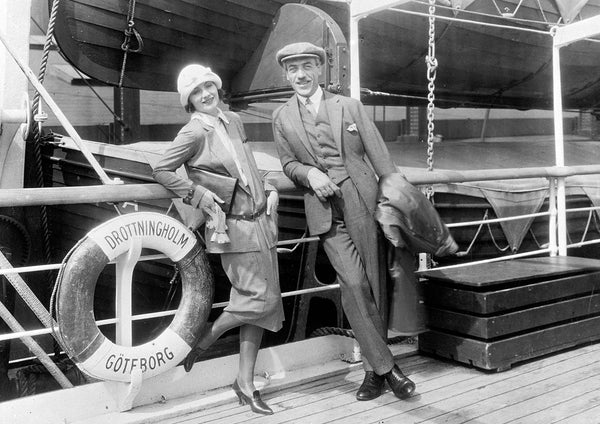I was recently invited to appraise an old well-used trunk that was set to be sold as part of a TV show taking a look behind the scenes of an auction house. I have bought and sold thousands of trunks and suitcases, but this trunk, which had been consigned to store linen, was no ordinary travel trunk. It was an antique Louis Vuitton trunk from the early 1910s.
Louis Vuitton has become one of the most recognisable fashion brands in the world. It is a huge global brand that makes highly desirable bags, shoes, fragrances and many more fashion accessories. But how did it all start? And how did Louis Vuitton come to make the best luggage in the world?

Louis Vuitton was born in, Anchay, a small hamlet in eastern France, in 1821. He left home at the age of 13 and it took him two years to walk the 292 miles to Paris as he worked to feed himself along the way. He started working as an apprentice box maker and packer to Monsieur Marechal. In those days packaging was custom made for items and so over the next 17 years Louis Vuitton honed his skills and became a master craftsman.
In 1853 he was appointed chief packer and trunk maker for Empress Eugenie de Montijo, wife of Napoleon III. She was newly married a keen to establish herself at the top of French society. Not unexpectedly French society was captivated by her fashion choices. She retained his luggage making and packing services for several years and she introduced Louis Vuitton’s skills to a wider French society, the rich and famous across Europe and America.

Louis Vuitton seated in the driver's seat.
In 1854 opened his own workshop and four years later in 1858 launches his pioneering Trianon trunk. It was lightweight, airtight and most notably flat-topped and covered in a grey canvas. This does not sound very revolutionary, but in the mid-1800s the vast majority of trunks were made of leather and with a domed (or humpback) top to allow water to run off their tops and not leak through to spoil the trunk's contents. His innovative trunks were soon copied and so he designed trunk ranges with different canvases. Trunks covered with a red and white striped 'Rayee' canvas were launched in 1872 and in 1876 a beige and brown striped canvas was used. A checked 'Damier' followed in 1886 in two colourways.

A Louis Vuitton Rayee brass-bound trunk made in 1889.
Despite the high quality of his trunks and his ever-growing reputation imitations of his innovative trunks were always appearing among the 1,000+ luggage makers across Europe and USA. In 1886 his son, Georges, invented and patented the tumbler lock that was unpickable and allowed a customer to use a single key to unlock all their LV luggage.
He continued to design, build and sell a wide array of trunks and luggage that changed as new and more comfortable modes of transport were invented. 1876 saw the introduction of wardrobe trunks large imposing trunks that stood on their ends and opened to reveal a hanging rail on side and a bank of different sized drawers on the other.

Designed to stop copycat imitations of his trunks, Louis Vuitton patented the Damier chequerboard canvas in 1888. Louis Vuitton passed away in 1892 and his son Georges took control of the company. He patented the iconic Monogram canvas patented by in 1896, to prevent counterfeiting. The canvas features LV letters, flowers and quarterfoils inspired by the Oriential designs that were popular at the time. The design is the brand's most iconic and most enduring feature. Locks, catches, fabric lining, belts, also branded with 'Louis Vuitton'. In fact almost everything in an LV trunk was branded with the logo even the rivets used to hold it together were branded LV.

Rapid advances in transport technology allowed passengers to go from horse-drawn carriages to steam trains; sail-ships to steam ships and finally to cars and aeroplanes. There were many trunks designed to be attached to the rear of cars. Different trunks were made to fit the contours of cars and improve their areodynamics. During the golden age of ocean travel from 1880s to 1960s there was an explosion of luggage designed to accompany the rich as they travelled to New York from Bristol, Liverpool and Glasgow and the major ports from around Europe. Britons also travelled to the four corners of the planet that would have seen them exploring Asia, Australia and Africa. Trunks for tropical climates would need to be watertight. Louis Vuitton used materials including, aluminium, copper, brass, as well as more unusual leathers and skins from alligators, crocodiles, walruses and elephants.

As immigration to the USA declined in the 1920s shipping line owners promoted the allure of exploring the USA and the lines competed to make the most luxurious ships. Accompanying luggage was big and equally as ostentatious. Air travel expanded and improved from the noisy, cramped and kerosene-engines smells of the 1930s and 40s. Bigger, faster and more comfortable planes started to cross the sea and land. This led to the demand for smaller lighter luggage and more compact trunks and suitcases soon overtook trunks.

At every stage Louis Vuitton was able to design functional well-made luggage for any mode of travel to any part of the globe. 1930 saw Louis Vuitton, under Louis' grandson, Gaston move away from heavy rigid structured luggage to their first mid-sized bag, the Keepall. It was followed by the Alma in 1932 and the Noe in 1934. And so in 90 years Louis Vuitton started a diversification that would see the company turn into the most desirable fashion brand in the century.
Through hard work, innovation, winning favour and influence Louis Vuitton pioneered trunk making at a time when travelling could only be done by the very affluent. But that was to soon change as travel was revolutionised first by steam trains, steam ships, the car and finally aeroplanes. His company designed some of the best luggage of the time and had luggage to suit any mode or location and function. His luggage was the best made from the best and often rarest materials by expert trunk makers.
By adapting to the trends and customer demands; diversifying into similar objects the company knew people would covert and making the best items money could buy, Louis Vuitton was certain to succeed.

The brand's enduring success was in part due to the rich and famous who bought Vuitton trunks and suitcases. These included the kings, queens, and royalty of Europe, as well as film stars, including Greeta Garbo. Ernest Hemingway had a library trunk custom-made for his books and typewriter. Louis Vuitton showed continued success in both luggage and handbags. In the 1950s and 1960s, jet-setting celebrities were often spotted with their Louis luggage.

The early 20th-century trunk I appraised in 2022
The Louis Vuitton hat trunk I viewed was in reasonable condition. The canvas was faded and scratched and there was a light dusting of corrosion on the metal rivets and edging, but it was structurally sound with no real damage. I estimated its valued at £4,000. The auction house listed it with a guide price between £4,000 to £6,000. It sold at auction for £7,300. Not a bad return for an old trunk bought for £12 in the 1980s!
Scaramanga has been stocking a range of vintage and antique trunks and wooden chests from around the world since 2008. We do not have any Louis Vuitton trunks, but Carl is always looking for one. We have over 250 original pieces available, in all sorts of shapes and sizes. Our prices start at just £85.


















